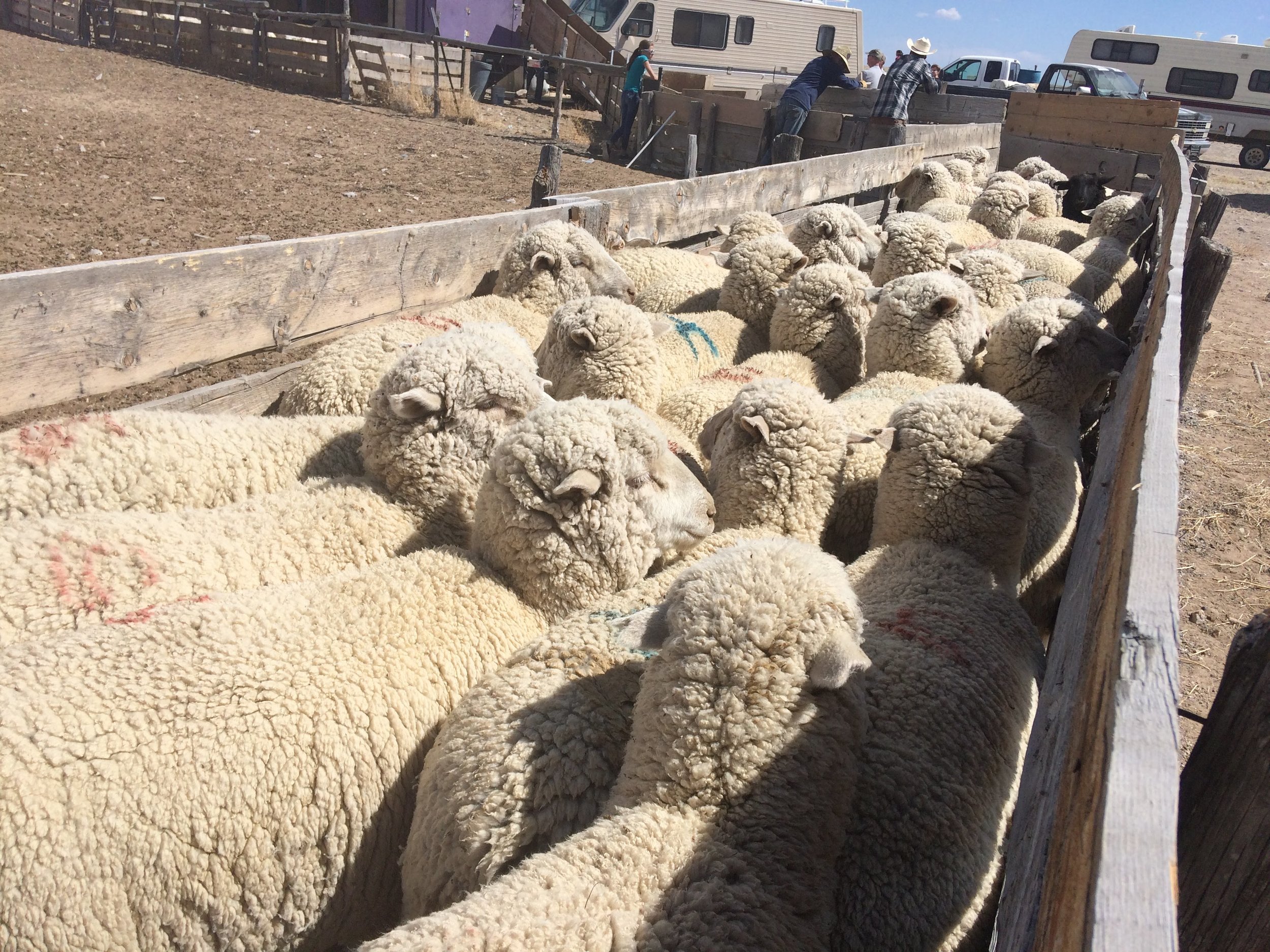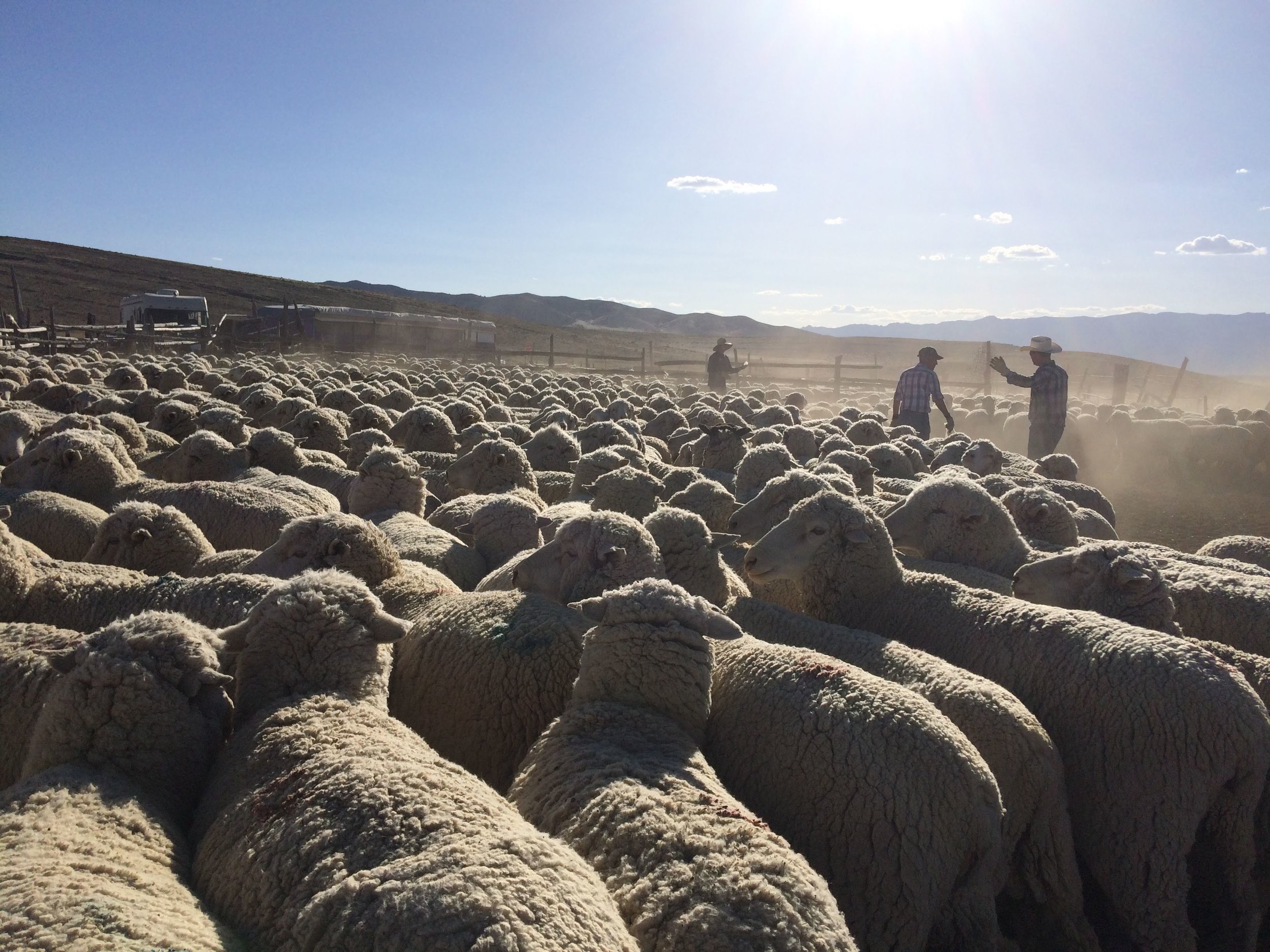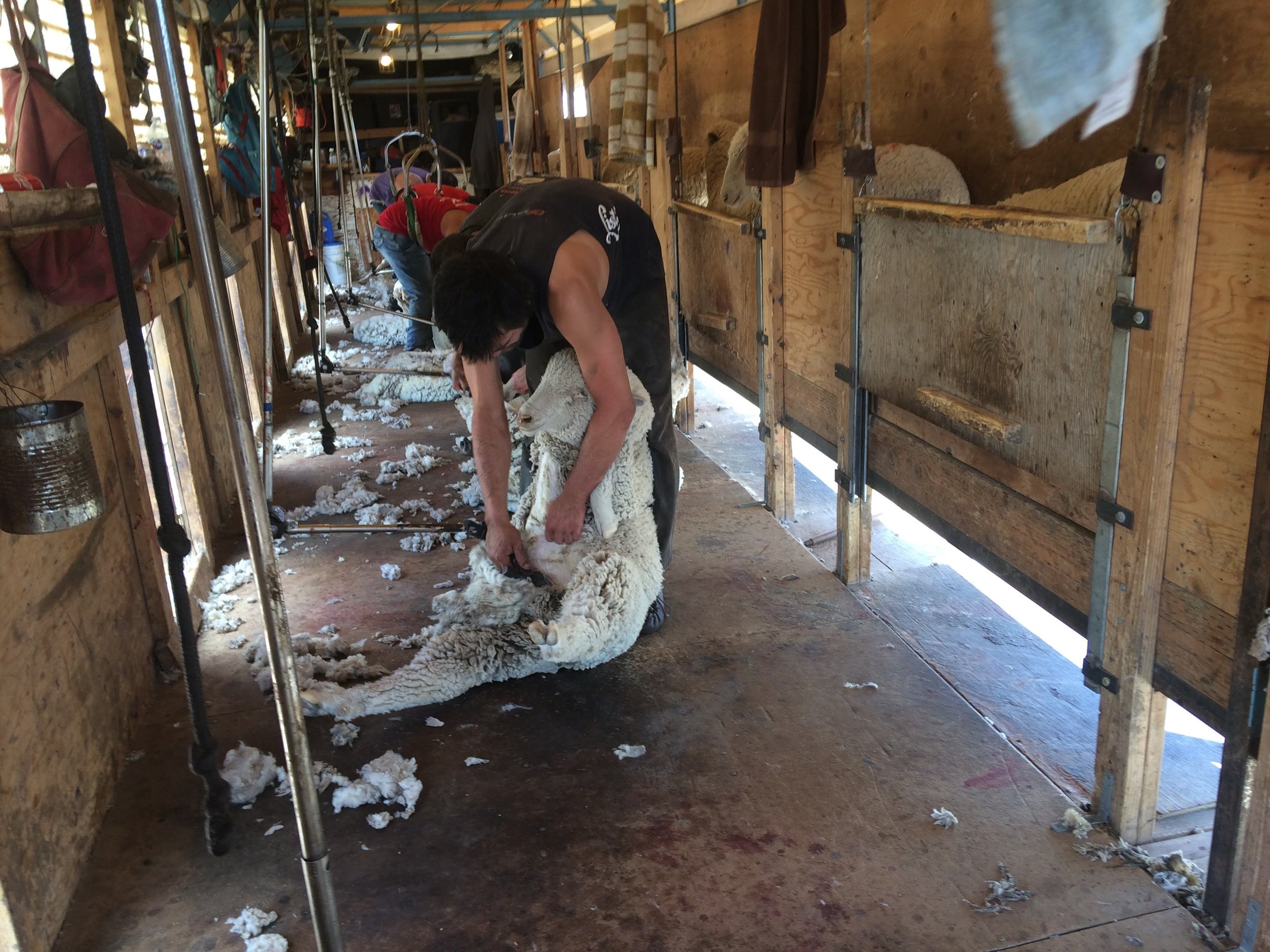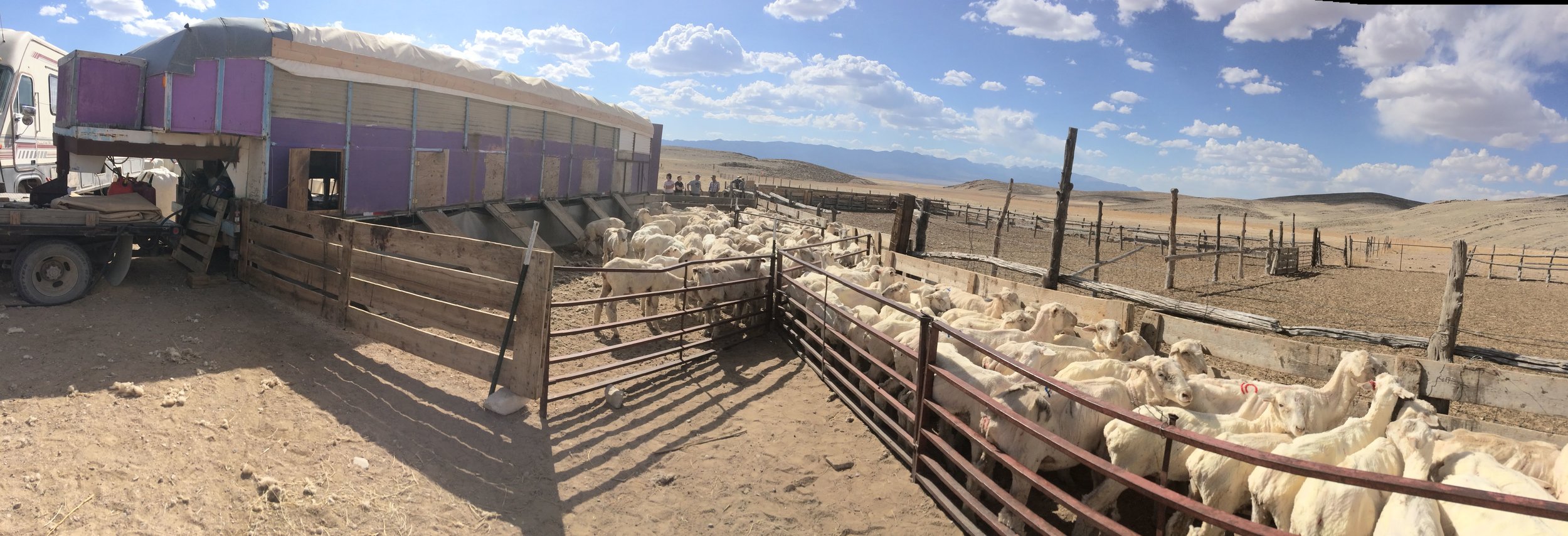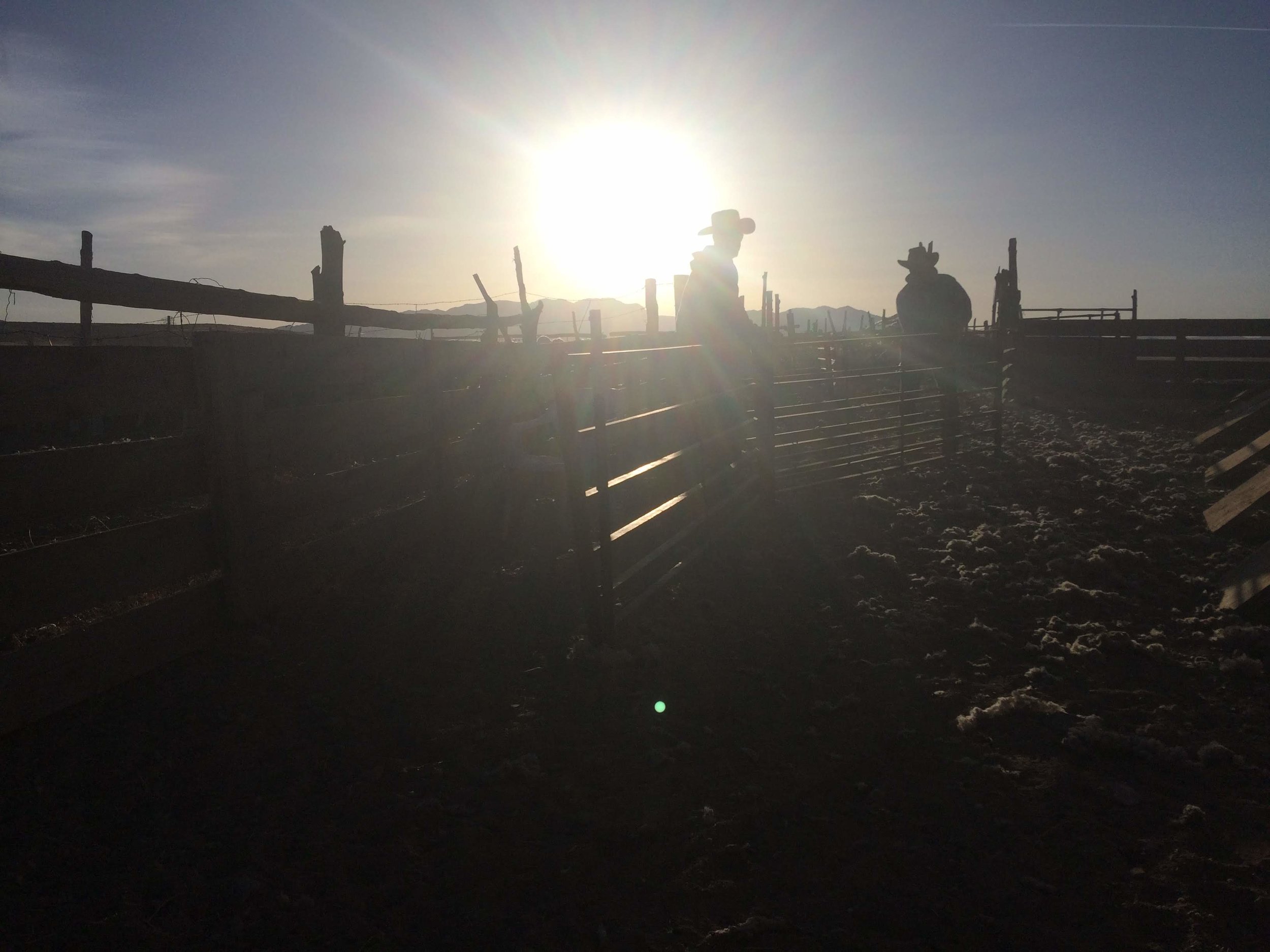Sheep Shearing
As the truck pulled up to the spring sheep shearing camp, I opened the door and stepped out into a warm dusty breeze. I walked over to the chute filled with sheep. Looking at the clustered sheep, I found myself focusing on one particular ewe. It was stuck between four other sheep, getting pushed forward even though it wanted to go back. I looked at it, and it at me, and its eyes rolled. The sheep’s eyes were golden, but not its fleece. Its fleece was a dingy white. The walls gradually narrowed in on each side, until the all the sheep, including this one, were moving single file. Moving is a relative term, because up ahead an ewe decided it didn’t want to keep moving, so it planted its hooves into the ground and stopped. And then, smashing its rear end into the face of the ewe that stood behind it, it started backing up, causing a pile-up. Someone walked by and jabbed the stubborn sheep with a stick and it bolted forward, clearing up the traffic jam.
The process continued. Single file. Step by step, the ewes went through the shoot, up a ramp and into a truck-bed that was specially designed with six sheering stations.
The shearers were mostly from New Zealand. They travel around the world shearing sheep. This was the end of the shearing season in the U.S. but in a few weeks a bunch of the shearers would fly to the U.K. where they would continue to shear. After that they’d go to Australia, and then back to New Zealand.
“Getting paid to travel the world,” I overheard one of them say. Not bad. Not easy either. They lived on the road, traveling from place to place, hauling RVs and fifth wheel trailers. They worked 8-10 hour days shearing sheep in a hot truck bed. On average it took a shearer about 2 minutes to shear one sheep. The best of them could shear one ewe in a minute and a half. In a perfect world, that equates to about 240 sheep per shearer in an eight-hour day. But they’re only human, so the six shearers total about 1000 sheep a day early in the season, and only about 800 by the season’s end. Dusty, dirty, hot or cold, tiring—not easy work at all.
“Lamb,” someone called. In a flash a small gate in the shoot was swung open, the lamb bolted through into the waiting pen, and the gate was closed. The lamb bounded around the pen, feeling free in enough space to run and jump. It wasn’t actually free, and it hadn’t escaped the discomfort of a shearing. The inevitable was just prolonged. The lambs or yearlings were culled from the ewes because their wool wasn’t as long or as fine, and the longer and finer the wool, the better the price. This was just a simple way of keeping the wool separate.
Unlike the shearers all the other shearing camp workers were local to Utah, and in this case local to the Anderson’s. These were Cory Anderson’s sheep. All five of his boys were here, some cousins as well, a few friends, and the two Hispanic sheepherders that worked for Cory all year. Every year at the end of April the Andersons made a reunion of the spring shearing season: their children, their children’s children, their cousins, and friends, would gather together, pulling their fifth wheel trailers or driving their RVs to set up camp in Utah’s west desert. Through the winter the Anderson’s ran their sheep so close to the Nevada state line that with a breeze at your back you could spit and hit a casino.
The process of shearing 2000 sheep, for most everyone, meant herding the sheep into the pens, moving them through the chute, culling out the lambs and the sheep with black in their wool, marking the sheared sheep with Cory’s brands, and then sending them back out to pasture until the following week when Cory would truck them to eastern Utah where his sheep spend the summer grazing in the Manti-La Sal National Forest.
Over the years, Lois, Cory’s wife, has literally done every job associated with shearing sheep. She regularly cooks breakfast, lunch, and dinner for 50 or so hungry people. Shearing sheep is hungry business, but Lois’ food would be considered delicious no matter where you had it. Lois has also herded the sheep through the chutes. She has chased coyotes preying on the herd. And as she tells it, one year she and a cousin decided they would save money if they were to pack the burlap bags full of wool and sew them shut themselves. When filled, these burlap bags can weigh between 450-475 pounds.
“They teased us at first [the other sheep workers], but by the end were surprised by how tight we could sew up the sacks,” she said. She went on to tell about how her fingers were raw and bloody by the end of the first day, but by that time she had committed, so she packed all the wool that year.
You wouldn’t think there was a whole lot of technical know how in moving sheep around, but that would be a mistake. In order to move the sheep from the pens into the chute, up the shoot and into the truck bed to the shearers, it took teamwork and coordination. First you had to chase 25-30 sheep from the pen into the chute. This took about 3 or 4 people working in unison to chase the wary sheep into the shoot. Usually all it took was for one of the ewes to decide the shoot looked better than the pen, and then all the other sheep would start to follow. Simple enough, until a different ewe decided it didn’t want to run up the shoot. Then that ewe would turn, and try to run the other way. If it made it past the pushers, another was sure to follow, and before you knew it a sheep jailbreak was on.
Once you got them into the chute, one person would stand behind the sheep, pushing them forward, while other people would line up alongside the outside of the shoot and jab or push the stubborn sheep toward the truck. But if you walked behind the sheep and tried to push them toward the truck they would inevitable decide to go the other way. The trick, as Nick Madsen told me (one of the Anderson’s friends) was to walk away from the truck, because if you walked against the current of the sheep they would continue to move towards the truck.
“It can feel counterintuitive, but it works,” he said. Nick also said that it is just the opposite with cattle. Cattle will willingly follow, whereas sheep prefer to avoid.
Even if you did all of this right, you always come across an ewe or two that is too stubborn to comply. At one point one of Cory’s boys and a cousin had to pick an ewe up from either end and carry it up the chute and into the truck bed to one of the shearers.
Once the sheep have gone from the pens, through the chute, and onto the truck bed, one of the shearers grabs it, and begins shearing. This is the part that seems like it would be the hardest to wrangle the sheep, but it’s not. It definitely takes precision and know how on the shearer’s part, but the moment a sheep is grabbed it goes from being a stubborn, belligerent participant to a docile creature. The shearers grab a sheep and flip it this way and that: one side then the other, onto its back then its front, they take the clippers and go between the ears of the animal and onto each of its legs. And all the while the sheep just goes with it. Once the shearing is finished they push the sheep onto a ramp that takes the sheep off the truck and into another pen before where they are branded.
The wool gets pushed the opposite direction from the sheep. It is gathered, graded (the longer and finer the wool the more it is worth), sorted, and then packed into large sacks that can hold about 450-475lbs of wool. This is the step that Lois and her cousin did, but now it isn’t as hard. You don’t’ have to sew the bags by hand, or pack it either. They have a big ‘ol generator run hydraulic wool baler that you stuff full and it compresses the wool. Then all you need to do is flip the edges of the sack and pull it tight with a few nifty tools. Still hard work, but not nearly as hard as doing it all by hand.
Generally there were two people separating and branding the sheep after they were sheared. Cory ran two herds in the summer, one blue and one red. The branders would look at the ear markings and mark the sheep with the designated color and brand. Some years back Cory had purchased a herd and brand from another herding family: the Anderson brand looked like a C with a line coming from the middle of the arc; the other brand, originally the Curtis’ was an underlined C. After the sheep were marked, the branders would return them to pasture until the trucks showed up to take them east.
By the end of the first day of shearing the shearers had managed about 825 sheep. By the time I’d left the shearing camp on the second day the shearers had sheared another 400 or so more sheep, with only 800 or so more to go.
